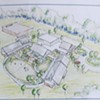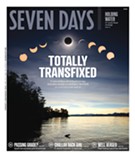Published November 2, 2011 at 11:57 a.m.
The escalating tension over a proposed new waterfront skatepark has all the elements of a classic Burlington development battle: generational antagonism, class issues, environmental concerns, arguments over aesthetics and, of course, litigation.
At issue is a replacement for the existing facility for skateboarders — a set of fenced-in wooden and metal ramps situated just east of the bike path near the Moran Plant. The envisioned skatepark would be nearly double the size and more than twice as expensive as the existing 10,000-square-foot facility that cost $326,000 to build 11 years ago.
Metal strips peeling off rotting wood in the current park pose dangers for skaters and bikers, warns James Maguire, a University of Vermont senior interning at the Ridin’ High skateboard shop on the corner of Pearl and Battery Streets. “A cut from a piece of metal sheeting can go pretty deep,” says Maguire, who skates “a healthy amount” at the waterfront park, which, he adds, “is not being properly taken care of.”
The city has done what it can to maintain brittle materials weathered by 11 Vermont winters, responds Kirstin Merriman Shapiro, special projects manager in the Community and Economic Development Office.
Rather than repair a park with an antiquated design, the city has approved the construction of a more durable and attractive replacement as part of its $4 million Waterfront North infrastructure project. This initiative, funded almost entirely by state and federal sources, involves realigning a portion of the bike path, burying utility lines, digging a storm-water retention pond, doubling the number of nearby parking spaces and installing better lighting on Lake Street. Waterfront North can go forward regardless of whether the Moran Plant makeover ever gets beyond the drawing board, says CEDO director Larry Kupferman.
The new skatepark would occupy the site to the northeast of the Community Sailing Center, where a set of roughly sculpted granite slabs, now covered with graffiti, were erected 20 years ago. Kupferman says these pieces will be put in storage pending a decision about their reuse.
The soil under the sculptures is contaminated with arsenic — residue from the coal pile that fed Moran for 30 years; the plant was taken offline in 1986. The toxic dirt will be scooped up and carted off for treatment before skatepark construction starts, says CEDO’s Nick Warner.
The roller-hockey and bike-polo rink alongside the existing skatepark will not be part of the new park. Discussions are under way with the Green Mountain Derby Dames about relocating the rink to Leddy or another city park, Kupferman says.
That’s where a new skateboard facility belongs, as well, according to some riled-up residents in the surrounding areas. In a recent letter to city planning officials, unnamed “representatives” complain that they are “frequently bombarded with ear-splitting, continuous noise” from events on the waterfront. A skatepark could amp up their headaches to migraine magnitude, they suggest — especially if it gets used at night.
To underscore their objections, 47 residents of Lakeview Terrace, North Avenue and Lake Street — including the subject of this week’s cover story, Alan Newman — are contesting aspects of the redevelopment plan in a suit filed recently in Vermont Superior Court. Such legal action could delay construction of the skatepark, tentatively scheduled to begin next spring, Kupferman says.
Missing from the list of aggrieved residents are tenants in the mixed-income project at 300 Lake Street. Organizers of the waterfront noise-abatement effort say they have sought unsuccessfully to gain support from occupants of that 40-unit building, which is much closer to both the current and planned skateparks than are the expensive condos and homes overlooking the project on the ridge that runs north from Battery Park.
That may be because they are renters, says one aggrieved homeowner, speaking on condition of anonymity, suggesting the conflict is as much about protecting property values as it is about excessive noise and other inconveniences.
The absence of fencing around the proposed skatepark is a primary concern for many opponents of the plan. They fear that the park, lit by new street fixtures nearby, will attract skaters long after the posted darkness-hour closing times for the existing park, which is officially open from April through October.
A fence will make skaters feel as though they’re “caged,” says Micah Shapiro, lead designer of the new park.
It will also destroy the “welcoming feel for families that we want to create there,” Kupferman adds.
The 8-foot-high chain-link fence around the existing park isn’t all that effective, acknowledges Cardy Raper, a party to the lawsuit. Skaters sometimes climb over the fence at night, she says. The noise from the park can be disturbing then and at some other times, adds Raper, who lives in the condo development alongside the police station. She notes, though, that calls to the police do bring immediate responses. And she says she’ll be satisfied with the new park if its users abide by the rules that are supposed to govern the existing park.
Designer Micah Shapiro assures neighbors that the new concrete facility will produce less noise than the hollow, wooden ramps of the old park.
Also in their letter to city planners, the worried homeowners point to “the fact that a skatepark serves only the young.” The perception is reinforced by skaters who claim the new park should be in a central location, such as the waterfront, because many in their ranks aren’t old enough to drive.
But the CEDO chief says the new park is intended for “people of all ages.” Moreover, skateboarders today don’t conform to the outlaw image of a decade ago, when they would “throw themselves against buildings and cause havoc,” Kupferman adds.
Josh Eichen, the 25-year-old co-organizer of the Burlington Skatepark Coalition, suggests that the homeowners’ objections arise from “preconceived notions of who skateboarders are and what skateparks are like.” Eichen’s group, which has some 1500 Facebook friends, has raised about $25,000 in private contributions for construction of the park. It’s appropriate to site it on the waterfront, he insists, because “that’s the city’s crown jewel and putting it there will show respect for skaters.”
The waterfront “belongs to everyone in Burlington,” Eichen adds. “Neighbors can’t assume the waterfront is their front yard.”
Shapiro, who works for Grindline Skateparks in Seattle, says the facility he’s designing will be the best and probably the biggest in New England. Eichen agrees, predicting that “it will attract skaters from all over.”
That’s precisely the scenario that is freaking out some of the neighbors. They’re alarmed at the prospect of hundreds of destination skaters descending on the waterfront.
Maguire, the Ridin’ High intern, fears that opponents of the new park will ultimately prevail. “A lot of us are skeptical that Burlington will allow it to happen,” he says of his fellow skaters. “Generally, skateboarders get pushed aside when it comes to redevelopment. It would be a tragedy, though, if we go backward from having a skatepark on the waterfront to not having one.”
Some of those filing suit on the park say they do support local skateboarders and are open to compromises. One of their chief complaints, however, is that the city has excluded them from discussions about the new park. “It seems as if the city has had little regard or care for the livability of our neighborhood or of our concerns,” they write in their letter to Burlington planning officials.
Kupferman says he has met with the residents on “multiple occasions” and intends to “continue the conversation with neighbors whether it’s in court or out.”
That’s the residents’ aim as well, affirms their attorney, Sam Hoar. “It’s the great hope of the neighbors to resolve this issue through negotiations with the city,” he says.
More By This Author
About the Artist

Matthew Thorsen
Bio:
Matthew Thorsen was a photographer for Seven Days 1995-2018. Read all about his life and work here.
Matthew Thorsen was a photographer for Seven Days 1995-2018. Read all about his life and work here.
Speaking of Local Matters, local Issues
-

At the Junction of State and Federal Law, I-91 Checkpoint Becomes Site of Legal Collision
Feb 5, 2014 -

Maple Makeover? Vermonters Discover a New Sugaring Technique
Feb 5, 2014 -

Disharmony on Prospect Street: A Dispute Between Neighbors Strikes a Sour Note
Feb 5, 2014 -

Treatment or Trial? Growing 'Rapid-Intervention' Program Gives Addicted Offenders a Choice
Jan 29, 2014 -

Raw Deal? Farmers Push Back Against Unpasteurized Milk Regulations
Jan 29, 2014 - More »
Comments
Comments are closed.
From 2014-2020, Seven Days allowed readers to comment on all stories posted on our website. While we've appreciated the suggestions and insights, right now Seven Days is prioritizing our core mission — producing high-quality, responsible local journalism — over moderating online debates between readers.
To criticize, correct or praise our reporting, please send us a letter to the editor or send us a tip. We’ll check it out and report the results.
Online comments may return when we have better tech tools for managing them. Thanks for reading.















































